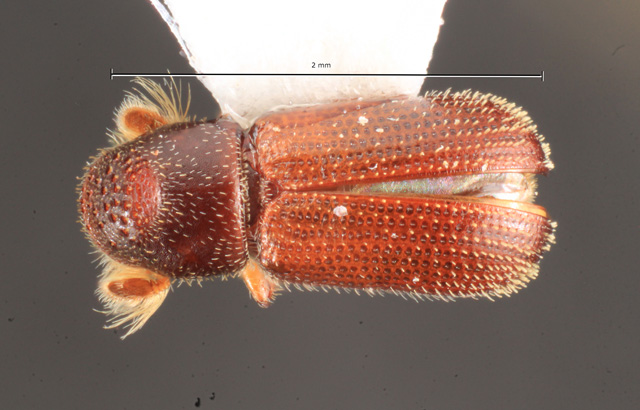Thysanoes fimbricornis LeConte 1876


 Images: Displaying 1 to 8 of 18
Images: Displaying 1 to 8 of 18 




 Thysanoes fimbricornis (female)
Thysanoes fimbricornis (female) |
 Thysanoes fimbricornis (female)
Thysanoes fimbricornis (female) |
 Thysanoes fimbricornis (female)
Thysanoes fimbricornis (female) |
 Thysanoes fimbricornis (female)
Thysanoes fimbricornis (female) |
 Thysanoes fimbricornis (female)
Thysanoes fimbricornis (female) |
 Thysanoes fimbricornis (female)
Thysanoes fimbricornis (female) |
 Thysanoes fimbricornis (female)
Thysanoes fimbricornis (female) |
 Thysanoes fimbricornis (female)
Thysanoes fimbricornis (female) |
| Next > |

Thysanoes fimbricornis (female) (by TH Atkinson, Biodiversity Center, University of Texas at Austin).
 Summary of Information
Summary of Information





SYNONYMY
- Thysanoes fimbricornis LeConte 1876. Proc. Amer. Philos. Soc. 15: 370
DISTRIBUTION.
Numbers in parentheses after each geographic unit are the number of distinct collection events in the database for that unit. For exotic species generally only countries are listed for localities outside the New World. For further information on published sources of distribution, check the REFERENCES section.
Distribution Comments. Southeastern United States to southern Mexico. In Mexico more common at intermediate elevations.
There are no distribution records in the database
HOSTS
Numbers in parentheses after each host family, genus, or collection method are the number of distinct collection events in the database for that host or method.
REFERENCES
The following are important recent monographs, catalogs, and supplements to catalogs that refer to this species. The specific page on which the reference is made is shown in pink at the end of the reference. In the case of Wood (1982) and Wood & Bright (1992) clicking on the reference page will link to a digital version of the work in question.
- Wood, S.L. 1982. The bark and ambrosia beetles of North and Central America (Coleoptera: Scolytidae), a taxonomic monograph. Great Basin Nat. Mem. 6:1-1356. [564]. (data capture complete)
- Wood, S.L., Bright,D.E. 1992. A catalog of Scolytidae and Platypodidae (Coleoptera), Part 2. Taxonomic Index. Great Basin Nat. Mem. 13:1-1553 (vol. A, B). [420]
The following are references from which host and distribution data have been input into the database. If one of the above monographs or catalogs also appears in this list, it means that most relevant collection event data have been included.
- . . .
- Blackman, M.W. 1920. North American Ipidae of the subfamily Micracinae, with descriptions of new species and genera. Miss. Agric. Exp. Sta. Tech.l Bull. 9 : 1-60.
- Blackman, M.W. 1928. Notes on Micracinae with descriptions of twelve new species. N.Y. State Coll. Forestry Tech. Publ. 25: 185-208.
- Chong, J.H., Weaver, J.S., Reid, L.S. 2012. New records of bark and ambrosia beetles (Coleoptera: Curculionidae: Scolytinae) from South Carolina, U.S.A. Coleopterists Bulletin 66(3): 250-252.
- Deyrup, M.A. 1981. Annotated list of Indiana Scolytidae (Coleoptera). Great Lakes Entomol. 14: 1-9.
- EDRR 2011. USFS Early Detection Rapid Response Database. http://www.fs.fed.us/invasivespecies/earlydetection.shtml/.
- EDRR 2014. USFS Early Detection Rapid Response Database. http://www.fs.fed.us/invasivespecies/earlydetection.shtml/.
- Rabaglia, R.J.; Valenti, M.A. 2003. Annotated list of the bark and ambrosia beetles (Coleoptera: Scolytidae) of Delaware, with new distribution records. Proc. Entomol. Soc. Wash. 105(2): 312-319.
- Viloria, Z.; Villanueva, R.T.; Bessin, R.; O'Neal, P.; Ranger, C.M.; Dunwell, W. 2021. Scolytinae in Nursery and Fruit Crops of Western Kentucky and Seasonal Population Patterns of Four Invasive Ambrosia beetles. J. Entomol. Sci. 56 (3): 374-386.
- Weber, B.C., MacPherson, J.E. 1991. Seasonal Flight Patterns Of Scolytidae (Coleoptera) In Black-Walnut Plantations In North-Carolina And Illinois. Coleopterists Bull. 45(1): 45-56.
- Wood, S.L. 1956. New species of bark beetles (Coleoptera: Scolytidae), mostly Mexican, Part II. Can. Entomol. 88(5): 231-240.
- Wood, S.L. 1982. The bark and ambrosia beetles of North and Central America (Coleoptera: Scolytidae), a taxonomic monograph. Great Basin Nat. Mem. 6: 1-1356.
 Distribution Map
Distribution Map





Maps automatically open at the center of the plotted points and the scale is set to encompass all map points. Maps can be resized (scale bar at upper left) and the center moved (place cursor over map and drag) to see other parts of the distribution of the species. Clicking on a map marker will pull up collection event data and a literature citation if present. If any errors are found, please refer to the "series code" which is a unique identifier for a database record in any communications). Coordinates have not been entered for all collection records. Localities outside the New World are not plotted, even though they are listed in the distribution summary and in the table of records.
There are no distribution records in the database
 Collection Records
Collection Records





There are no distribution records in the database
Return to top of page
